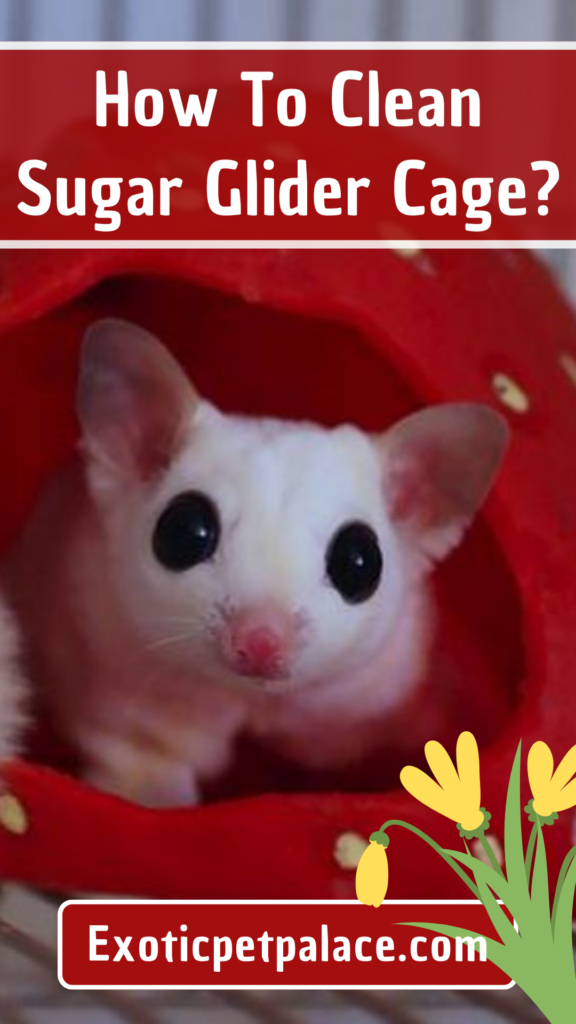Sugar gliders are adorable, social marsupials that make delightful pets.
To survive, though, they need a tidy and sanitary dwelling space, just like any other animal.
A dirty cage can lead to unpleasant odors, respiratory problems, and even bacterial infections for your furry friend.
By cleaning your sugar glider cage properly, you can ensure their well-being and continue to enjoy their companionship.
This article will provide you with the information and techniques on “How To Clean Sugar Glider Cage?”
So, Stay with us till the end.
Read Also: How to bond with a sugar glider?
Importance of Cage Cleaning:
Sugar gliders often leave behind food scraps, urine, and droppings, which can accumulate and cause health problems.
Regular cage cleaning helps maintain a healthy environment by preventing harmful bacteria growth and ammonia buildup.
It also reduces unpleasant odors, creating a more enjoyable living space for both pet and owner.
A hygienic environment minimizes the risk of respiratory issues and other potential health issues.
Frequency of Sugar Glider Cage Cleaning:
The optimal cleaning frequency depends on several factors specific to your sugar gliders and their environment:
- Number of Sugar Gliders: Naturally, more gliders will produce more waste, necessitating more frequent cleaning.
- Cage Size: A larger cage provides more space for waste to disperse, allowing for slightly less frequent cleaning compared to a smaller one.
- Diet: A diet high in moisture (fruits) will lead to more frequent cleaning needs compared to a drier diet (pellets).
Here’s a recommended cleaning schedule to keep your gliders happy and healthy:
- Spot Cleaning (Daily): This quick daily task involves removing fresh droppings, uneaten food scraps, and soiled bedding areas.
- Deep Cleaning (Weekly): Perform a thorough deep clean every 1-2 weeks. This involves cleaning the entire cage, toys, and accessories.
- Complete Disinfection (Quarterly): Every 3-4 months, disinfect the entire cage using a safe cleaning solution (explained later).
Cleaning Supplies:
Before diving into the cleaning process, ensure you have all the necessary supplies to ensure a safe and effective clean:
- Safe Cleaning Solution: Harsh chemicals are a big no-no! opt for a gentle solution of warm water with a few drops of unscented dish soap (like Dawn) or a pet-safe cage cleaner. White vinegar diluted with water (1:4 ratio) can also be used for disinfecting.
- Disinfectant: Look for products labelled “safe for small animals” or consult your veterinarian for recommendations.
- Cleaning Tools: Stock up on sponges, rags, non-abrasive scrub brushes for stubborn grime, and a bucket for your cleaning solution.
- Fresh Bedding: Replace all old bedding with a generous layer of fresh, absorbent material like aspen shavings, shredded paper towels, or fleece liners.
- Drying Towels: Paper towels or clean dish towels are ideal for drying the cage after cleaning.
Important Note: Never use harsh chemicals, bleach, or ammonia-based cleaners in your sugar glider cage. These can be toxic to your pet and leave harmful residues.
How To Clean Sugar Glider Cage?
Now lets start cleaning of glider’s cage. Here is the cleaning process: A Step-by-Step Guide for a Sparkling Cage.
This process is involve 5 simple and easy steps:
- Preparing for Cleaning
- Spot Cleaning (Daily)
- Deep Cleaning (Weekly)
- Disinfection (Quarterly)
- Reassembly and Finishing Touches
Lets dive into each step:
Step #1: Preparing for Cleaning
In this process we just start the preparation of cleaning by:
- Move Your Sugar Gliders: Provide your sugar gliders with a safe, temporary enclosure with familiar toys and a pouch to hide in. A playpen or carrier works well.
- Remove All Accessories: Take out all cage accessories like food and water bowls, toys, pouches, and climbing structures for thorough cleaning.
- Line the Bottom: Line the bottom of the cage with newspaper to catch any debris during cleaning. This newspaper will be discarded later.
Step # 2: Spot Cleaning (Daily)
- Use a damp cloth or paper towel to remove fresh droppings, spilled food, and soiled bedding areas.
- Dispose of waste immediately in a sealed bag to prevent odors.
Step # 3: Deep Cleaning (Weekly):
In this process we deeply clean the cage by:
- Discard the Old: Remove the newspaper lining and discard all soiled bedding.
- Prepare the Cleaning Solution: Fill your bucket with warm water and your chosen cleaning solution.
- Scrub and Rinse: Wash the cage walls, floors, and bars with the cleaning solution and a sponge or rag. Pay extra attention to corners, gaps, and locations where trash accumulates. Use a smooth scrub brush with mild pressure to remove stubborn trash without harming the cage material.
- Rinse thoroughly: After cleaning the entire cage, wash it well with clean water to eliminate any soap residue.
- Rinse with clean water from the tap or in a separate bucket filled with clean water.
- Clean the Accessories: Using the same cleaning solution, wash all cage accessories, such as food and water bowls, toys, and climbing structures. Consider soaking severely dirty objects to make cleaning simpler. To clean toys with complicated pieces, use a little bottle brush.
- Rinse and Dry Accessories: Properly rinse all accessories with clean water and let them air dry on a clean towel or drying rack. Never return wet equipment to the cage since moisture promotes fungus development.
Step # 4: Disinfection (Quarterly)
Follow Steps 1 and 2 from Deep Cleaning: Refer back to the steps mentioned earlier for preparing for cleaning and removing all accessories.
- Safe Disinfection: Dilute your chosen disinfectant solution according to the manufacturer’s instructions. Wearing gloves is crucial to protect your hands from the disinfectant.
- Thorough Disinfection: Thoroughly disinfect all cage surfaces, bars, and accessories with the diluted disinfectant solution. Ensure all areas are damp but not soaked to prevent excessive dripping.
- Contact Time: Allow the disinfectant solution to sit for the recommended contact time (usually 10-15 minutes) as stated on the product label. This ensures proper disinfection by killing bacteria and viruses.
- Crucial Rinsing: After the contact time, rinse the entire cage and accessories thoroughly with clean water to remove any disinfectant residue. Rinsing is essential to prevent the disinfectant from harming your sugar gliders if they ingest any residual traces.
- Drying Completely: Allow everything to air dry completely before reassembling the cage. Sun drying is a great option for additional disinfection, but ensure the cage is completely out of direct sunlight to prevent overheating. Alternatively, use clean towels to speed up the drying process.
Step # 5: Reassembly and Finishing Touches
Finally we are at the last stage of cleaning cage of your sweet glider.
- Fresh Bedding: Once everything is dry, replace the soiled newspaper lining with a fresh layer of absorbent bedding.
- Reassemble the Cage: Carefully place the cleaned accessories back in their designated spots, ensuring everything is secure and accessible for your gliders.
Welcome Home! Finally, introduce your sugar gliders back into their clean and refreshed home! They’ll likely appreciate the fresh scent and clean environment.
Also Read: How do I know if my sugar glider is dying?
5 Tips for Maintaining a Clean Cage
By incorporating these additional tips into your routine, you can further ensure a clean and healthy environment for your sugar gliders:
- Multiple Food and Water Bowls: Provide multiple food and water bowls distributed throughout the cage. This helps to distribute waste and prevent concentrated areas of soiling.
- Litter Box Training: Train your sugar gliders to use a designated litter box. This can significantly reduce the amount of spot cleaning required and minimize the spread of waste throughout the cage.
- Cage Material: Consider using solid-bottom cages for easier cleaning compared to cages with wire mesh bottoms where waste can fall through. Solid-bottom cages also provide a more secure footing for your gliders.
- Fleece Liners: Fleece liners can be a great alternative to traditional bedding. They are washable and reusable, reducing waste and cleaning frequency. However, fleece liners require daily spot cleaning and regular washing to prevent ammonia buildup.
- Monitor Health: Regularly monitor your sugar gliders’ health. Any changes in their behavior, appetite, or respiratory function could indicate a health issue potentially linked to a dirty cage environment. If you notice any concerning signs, consult your veterinarian promptly.
By following these steps and incorporating these tips, you can ensure that your sugar gliders live in a clean, healthy, and comfortable environment.
This not only promotes their well-being but also allows you to enjoy their company to the fullest, creating a lasting bond with these fascinating creatures.
FAQs
Q: Is using vinegar to clean a sugar glider cage safe?
A: Yes! As a natural disinfectant, vinegar kills bacteria, viruses, and other microorganisms.
Cleaning the cage only requires diluting vinegar with water. Make sure you thoroughly clean the cage to get rid of any vinegar residue afterward.
Avoid using cedar and pine, use standard laundry detergent, and use hot water for cleaning.
Relocate gliders to a small travel cage, use vinegar and hot water, and focus on sleeping pouches.
Q: How Often Should You Clean A Sugar Gliders Cage
A: Sugar gliders require a clean cage at least once a week to prevent waste build-up and health issues.
The best time to clean is in the evening, as they are more active at night.
The frequency and size of cage cleaning depend on the number and type of animals, with larger cages requiring more cleaning.
However, the cleaning amount is usually between 30 minutes and an hour per week.
Conclusion: A Clean Cage for Happy Gliders
Maintaining a clean cage for your sugar gliders is an essential aspect of responsible pet ownership.
By following the steps outlined in this guide and incorporating the additional tips, you can create a healthy and hygienic environment for your furry friends.
A clean cage not only reduces unpleasant odors but also minimizes the risk of respiratory issues and other health problems.
Remember, a little effort on your part goes a long way in ensuring the well-being and happiness of your sugar gliders.
So, grab your cleaning supplies, roll up your sleeves, and get ready to create a sparkling cage that your sugar gliders will love!
Happy Cleaning!😊
I hope you like this post and find it helpful. Please pin📌 it and share it with others.


